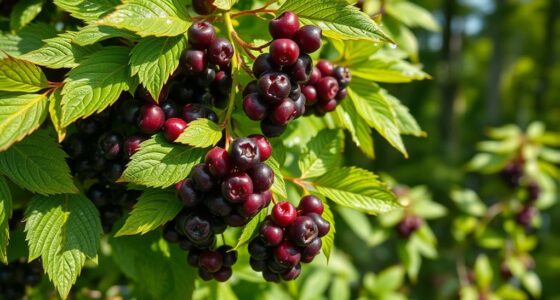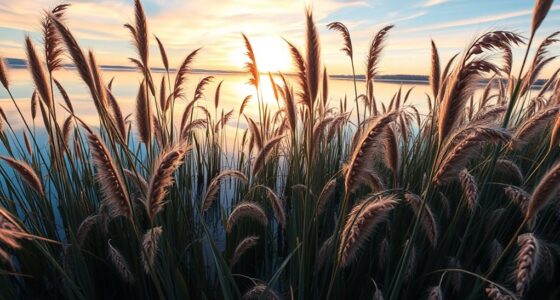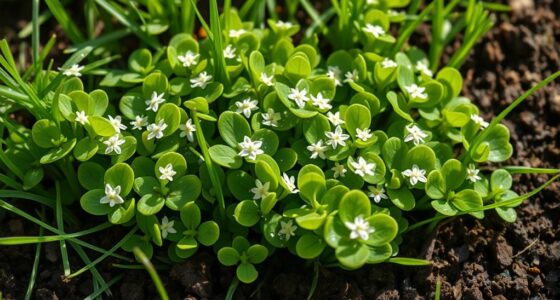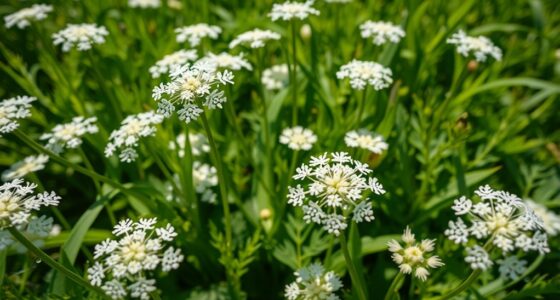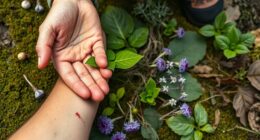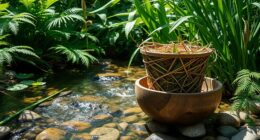To identify wild garlic, look for long, spear-shaped leaves with a strong garlic scent when crushed, and white, star-shaped flowers in late spring. Confirm it by gently crushing a leaf to check for that distinctive smell, and avoid look-alikes like Lily of the Valley. When harvesting, pick healthy leaves during early spring, using scissors or fingers, and don’t uproot the plant. For more tips on safe harvesting and tasty uses, keep exploring.
Key Takeaways
- Look for long, pointed, spear-shaped leaves with a strong garlic or onion scent when crushed.
- Confirm by crushing leaves to check for a pungent garlicky aroma; avoid look-alikes like Lily of the Valley.
- Identify white, star-shaped flowers in a ball cluster that bloom from early spring to early summer.
- Harvest during morning hours from moist, semi-shaded areas, picking healthy leaves without uprooting bulbs.
- Use sustainable practices by harvesting only what’s needed, avoiding overharvesting, and respecting local regulations.
Recognizing the Key Features of Wild Garlic

How can you confidently recognize wild garlic in the wild? Start by looking in semi-shaded, moist areas like forests and farmland near water. The plant has long, pointed, oval leaves with untoothed edges that hang down as they mature. When crushed, the leaves emit a strong garlicky scent, similar to garlic and chives. Plant identification techniques can help you better understand plant features and identify wild garlic more accurately. Wild garlic produces small, white, star-shaped flowers with six petals, arranged in a ball-like cluster. It grows from a bulb that resembles an elongated garlic clove. The stems support these flower clusters and grow taller over time. Pay attention to the smell, leaf shape, and growth habitat, which are the clearest clues to identifying this plant. Recognizing these key features helps distinguish wild garlic from similar-looking plants. Additionally, observing its distinctive garlic aroma when leaves are crushed can provide a crucial identification tip. Incorporating knowledge about its cultivation environment can further aid in accurate recognition.
Safely Confirming Wild Garlic in the Field
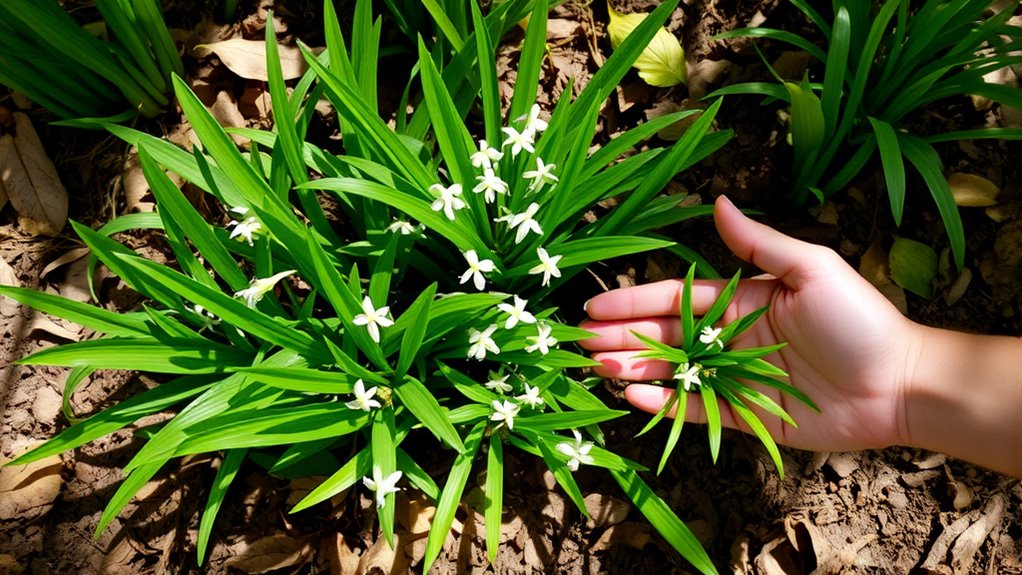
Wondering if you’ve correctly identified wild garlic? First, crush a leaf and check for a strong garlic or onion scent—this is your primary clue. Observe the leaves: they should be pointed, spear-shaped, with a single vein running down the middle, and have a paler green, matte underside. Proper identification methods are crucial to avoid confusing wild garlic with look-alikes. Each stem emerges from a single bulb, typically with one leaf. When flowers appear later, look for white, ball-shaped clusters. Be cautious of look-alikes: Lily of the Valley lacks scent and has multiple leaves per stem; Star of Bethlehem has no onion smell and different leaf structure. Confirm your find by verifying these features in the plant’s environment, and if in doubt, perform a small taste test or consult local experts. Additionally, understanding the contrast ratio can help you better observe subtle differences in plant features under various lighting conditions. Recognizing the growth pattern of wild garlic can further assist in accurate identification, as it tends to grow in clusters or patches in shaded, moist areas. Being aware of seasonal changes can also aid in proper identification, since wild garlic typically blooms in early spring. Moreover, paying attention to the plant’s habitat can provide valuable clues, since wild garlic prefers specific soil and light conditions that can help distinguish it from similar species.
Best Practices for Harvesting Wild Garlic

Once you’ve confidently identified wild garlic in the field, it’s important to harvest it responsibly to guarantee its sustainability. Focus on picking healthy, vibrant green leaves, preferably long ones, without uprooting the plant or bulbs. Always harvest from different parts of the area to prevent overharvesting in one spot. Handle the leaves gently to avoid bruising. Using simple tools like scissors or fingers helps minimize damage to the plant and ensures proper harvesting techniques. Use no tools—simply snip the leaves at the base with your fingers or scissors. Be mindful of the environment; only take what you need and avoid disturbing wildlife. Ensure you have permission if harvesting on private land and respect local regulations. Practicing sustainable harvesting helps preserve wild garlic populations for future foragers. Additionally, observing wild plant conservation principles encourages responsible foraging and environmental stewardship.
Proper Methods for Storing Wild Garlic

Properly storing wild garlic guarantees you can enjoy its fresh flavor long after harvesting. For short-term storage, wrap fresh wild garlic in a damp towel and keep it in the fridge for up to two days. Handle it gently to prevent bruising and maintain its aroma. Celebrity lifestyle insights reveal that even simple preservation methods can be elevated with creative presentation. To preserve it longer, consider freezing in oil or broth—chop the leaves, place in ice cube trays, and freeze. You can also make an oil paste, store it in sterilized jars, and keep it in the fridge or freeze for extended use. Another method is vodka infusion, where wild garlic is combined with vodka and stored in a dark cupboard for a couple of months. Always use clean jars, label your storage, and keep wild garlic separate from other foods to prevent contamination. Understanding proper storage techniques is essential to maintain the quality and safety of your wild garlic.
Delicious Ways to Use Wild Garlic in Cooking

Wild garlic adds vibrant flavor and aroma to a variety of dishes, making it a versatile ingredient in your kitchen. You can create wild garlic pesto by blending leaves with olive oil, nuts, and Parmesan, or preserve its flavor by pickling it for year-round use.
Wild garlic butter melts into roasted vegetables or spreads on bread, while wild garlic oil captures its essence for salads and dips. Incorporate it into main courses like roast chicken with herbs, creamy mushroom risotto, or wild garlic ravioli for an extra punch.
It also shines in sides and snacks—think crispy potatoes with pesto mayo, chickpea flatbread, or stuffed vegetables. These methods enhance your dishes with bold, fresh flavor and allow you to enjoy wild garlic beyond its harvest. Juice extraction techniques can help you maximize the nutritional benefits of wild garlic, ensuring you get the most out of this flavorful herb. Additionally, understanding self watering plant pots can assist in maintaining healthy plants, including herbs like wild garlic, by providing consistent moisture. Proper harvesting techniques can also ensure the plant remains healthy and vigorous for future growth. When harvesting wild garlic, gear shifting knowledge can help you identify the best times and methods to collect leaves without damaging the plant. To ensure sustainable harvesting, it is important to learn about plant maintenance practices that support the growth of wild garlic.
Tips for Sustainable Wild Garlic Foraging

Ever wondered how to enjoy wild garlic without harming the environment? To do so, only pick a few leaves from each plant, ensuring it can continue growing. Use secateurs or your fingers to gently pull leaves from the base, avoiding uprooting entire plants. Focus on younger, tender leaves rather than older, tougher ones. Always harvest in moderation so that wildlife and future plants still have access to the foliage. Follow local foraging rules to stay legal and sustainable. Look for wild garlic in shady, damp woodland areas with rich soil, avoiding heavily trafficked or polluted sites. The best time to harvest is from March to early June, preferably in the morning. By practicing these tips, you’ll help preserve this precious plant for generations. Remember that supporting sustainable foraging practices ensures the longevity of wild garlic populations. Additionally, being aware of home security systems can help protect your foraging supplies and home environment from theft or intrusion. Incorporating knowledge about plant ecology can further enhance your responsible harvesting practices. Understanding the role of sound design in ecosystem awareness can deepen your appreciation for natural habitats, encouraging more mindful foraging. Being mindful of biodiversity helps maintain healthy ecosystems where wild garlic naturally thrives.
Frequently Asked Questions
Can Wild Garlic Be Confused With Any Poisonous Plants?
Yes, wild garlic can be confused with poisonous plants like Lily of the Valley and Autumn Crocus. You need to pay close attention to key features like scent, leaf shape, and flower structure.
Wild garlic has a strong garlic smell, broad flat leaves, and star-shaped white flowers. Always double-check these details and, when unsure, consult an expert or use reliable guides to avoid dangerous misidentification.
Is It Safe for Pregnant Women to Forage Wild Garlic?
You might wonder if it’s safe for pregnant women to forage wild garlic. While moderate consumption is generally safe and offers health benefits like boosted immunity, you should be cautious.
Wild garlic contains blood-thinning properties and can cause digestive issues if eaten in large amounts. Always identify it correctly, avoid overconsumption, and consult your healthcare provider before foraging or eating it during pregnancy to guarantee safety.
How Can I Tell if Wild Garlic Has Gone Bad?
To tell if wild garlic has gone bad, look for visual signs like browning, wilting, or mold on the leaves.
Smell for sour or unpleasant odors, which indicate spoilage.
Feel the texture—if the leaves are limp or soggy, they’re likely spoiled.
Also, check storage conditions; improper storage speeds up spoilage.
Always wash the leaves thoroughly before use to remove potential contaminants and guarantee freshness before consuming.
Are There Any Legal Restrictions on Foraging Wild Garlic Locally?
Remember, “knowledge is power.” When it comes to foraging wild garlic locally, you should be conscious of legal restrictions.
You can pick leaves on public footpaths without landowner permission, but uprooting bulbs or foraging on private land requires consent.
Restrictions also exist in protected areas or Sites of Special Scientific Interest.
Always respect land rules and conservation efforts to ensure sustainable foraging and avoid legal issues.
What Are the Signs of Overharvesting in Wild Garlic Populations?
You should watch for signs of overharvesting in wild garlic, like fewer plants, weaker growth, or a noticeable decline in density. If you see fewer seed pods or reduced vigor in the plants, it indicates overharvesting.
Over-picking can also cause habitat disturbance and erosion. To prevent this, harvest sparingly, leave seed pods intact, and avoid heavily trafficked areas to ensure wild garlic populations stay healthy and sustainable.
Conclusion
Now that you know how to recognize, harvest, and enjoy wild garlic, you’re like a skilled gardener tending to a treasured secret. With each leaf you gather, you’re collecting a burst of fresh, woodland magic. Respect the land that gifts you this bounty, and it will reward you with seasons of abundance. Embrace the adventure, and let wild garlic be your flavorful compass on your foraging journey. Happy hunting!



